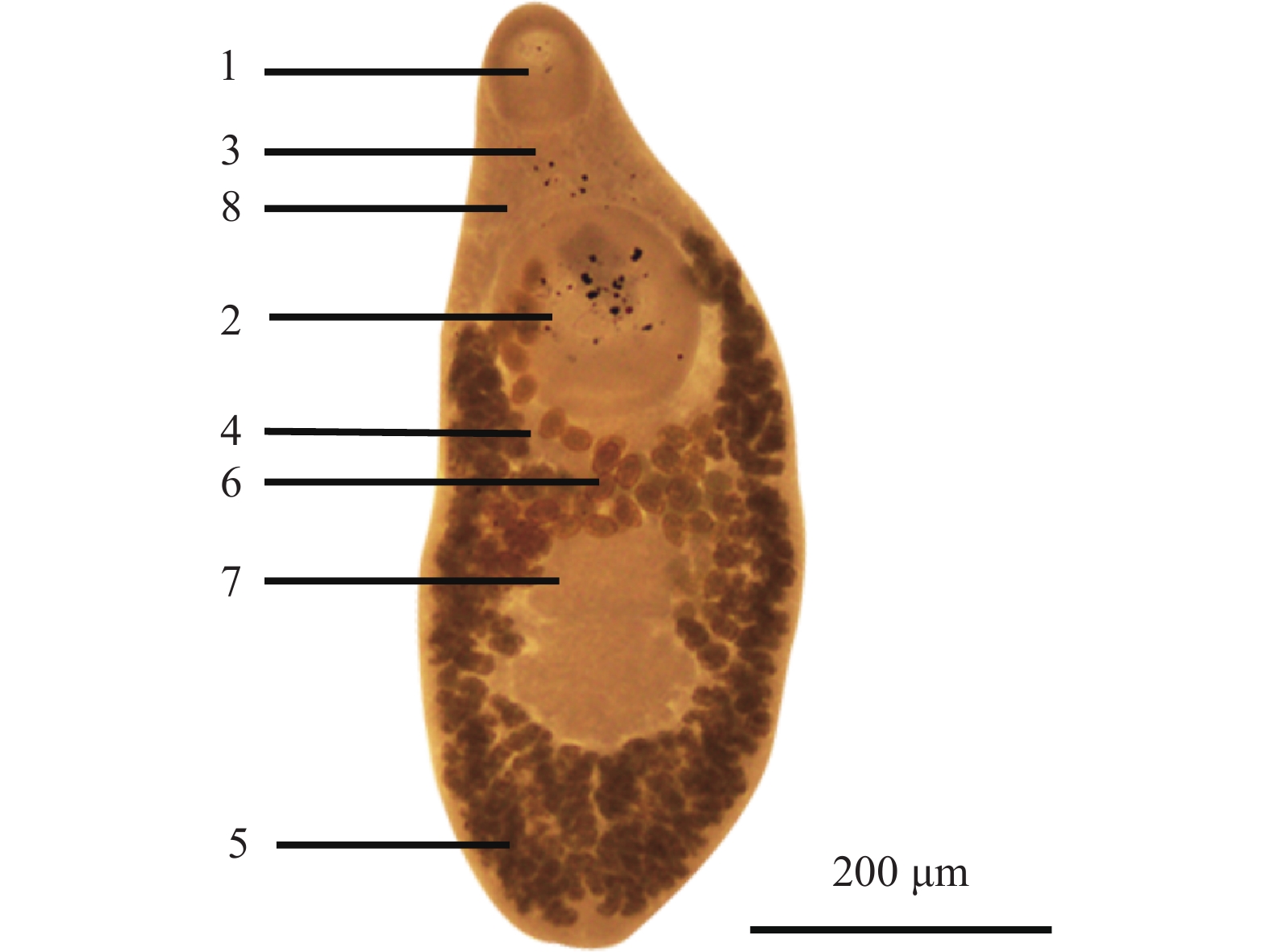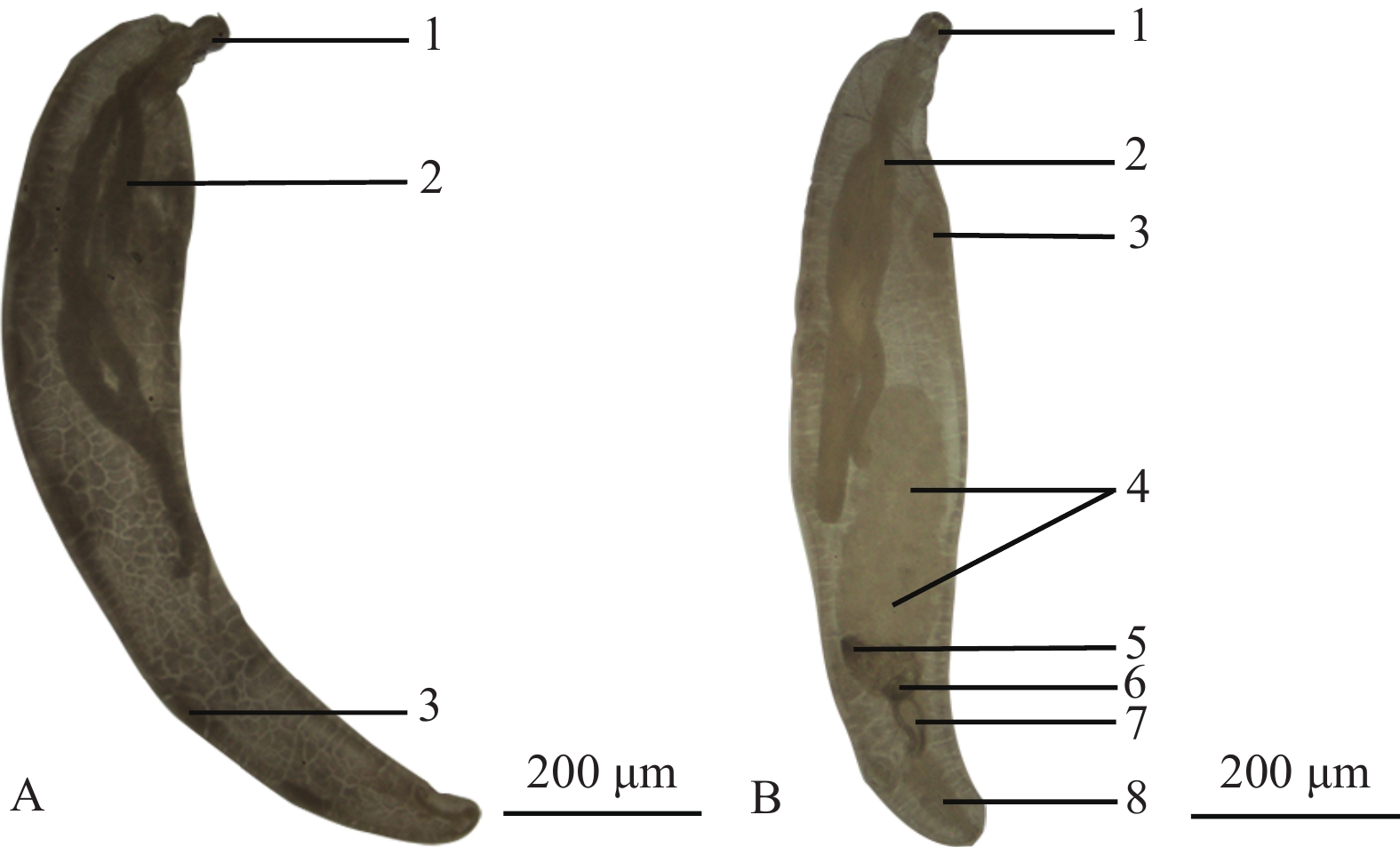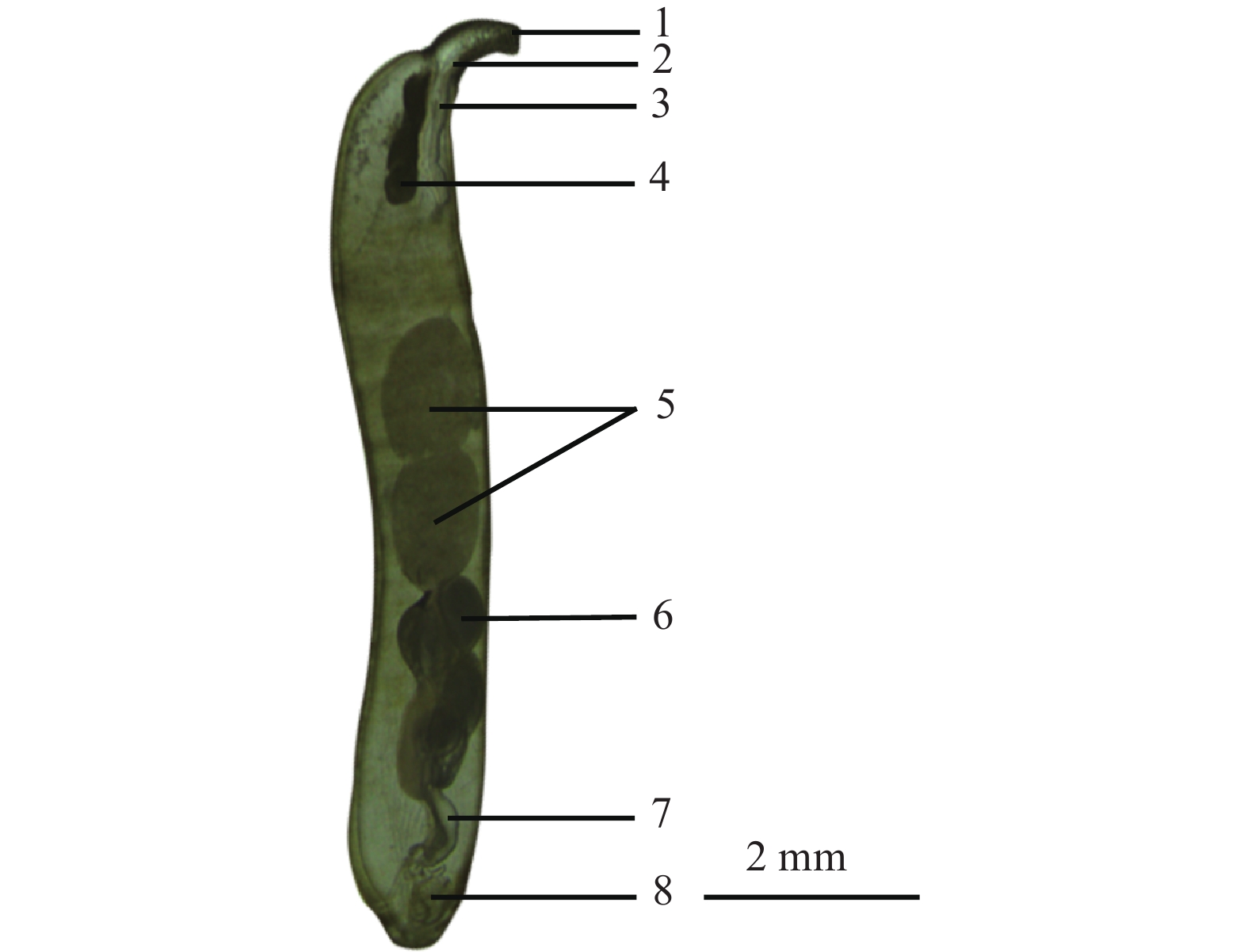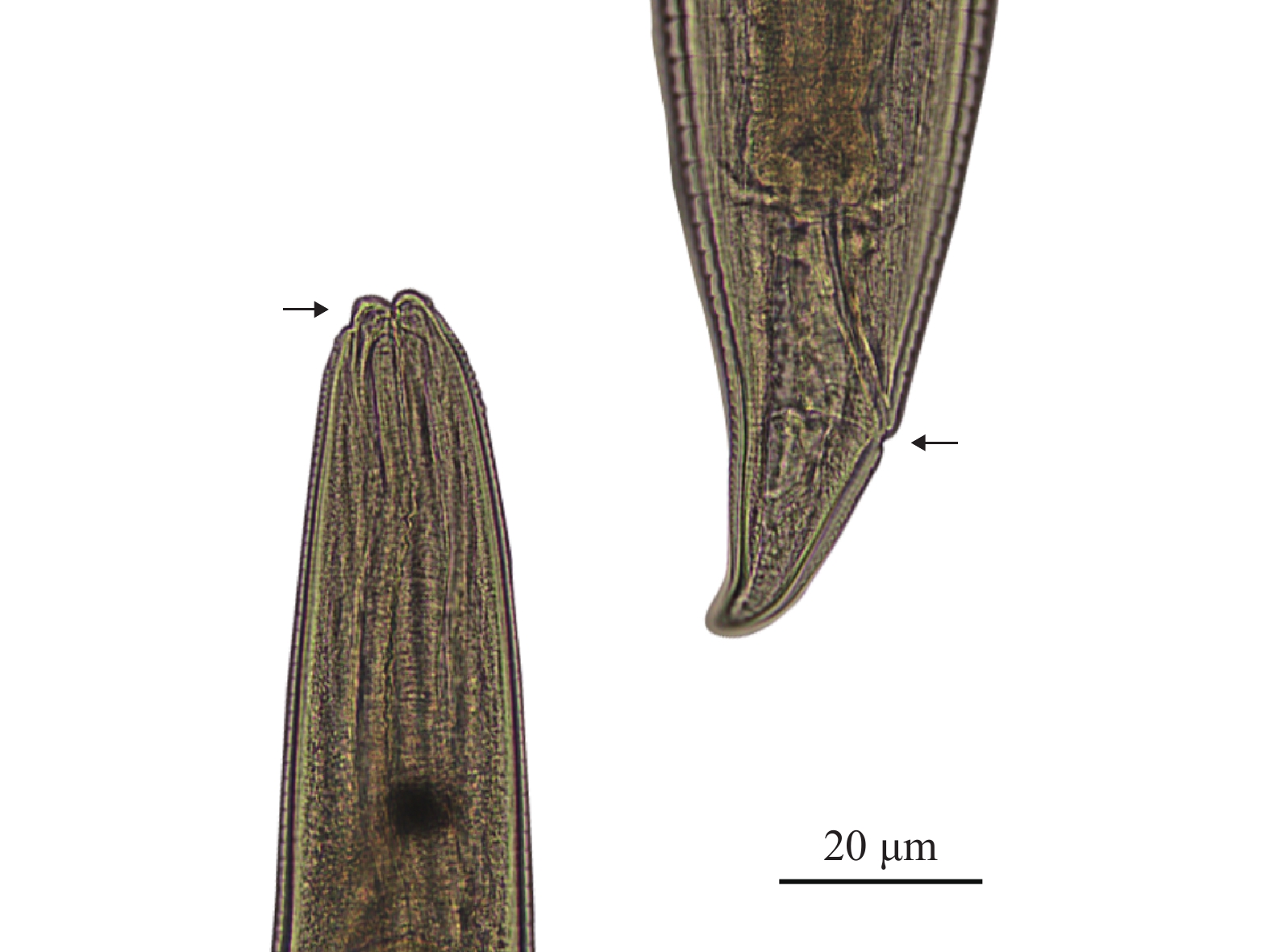COMMUNITY STRUCTURE AND INFECTION OF GASTROINTESTINAL HELMINTHS IN GLYPTOSTERNUM MACULATUM FROM TIBET AUTONOMOUS REGION, CHINA
-
摘要: 为了解西藏特有鱼类黑斑原鮡(Glyptosternum maculatum)消化道寄生蠕虫的群落结构和感染情况, 于2019年5—8月对383尾黑斑原鮡进行了调查。在黑斑原鮡消化道中共发现7种寄生蠕虫, 分别为深槽绦虫未定种(Bothriocephalus sp.)、原头绦虫未定种(Proteocephalus sp.)、异肉吸虫未定种(Allocreadium sp.)、新棘吻虫未定种(Neoechinorhynchus sp.)、裸鲤棘头虫(Echinorhynchus gymnocyprii)、Contracaecum eudyptulae和杆咽线虫未定种(Rhabdochona sp.), 并对各个物种的形态特征进行了描述。将黑斑原鮡按整个群体、不同性别和不同全长群体进行划分, 分别对其消化道寄生蠕虫的群落多样性和优势虫种进行分析, 并对各寄生蠕虫物种的感染情况进行统计。结果表明: 在黑斑原鮡群体中, 消化道寄生蠕虫群落的Shannon-Wiener指数为1.53, Berger-Parker指数为0.37, 优势物种为C. eudyptulae, 其感染数量、感染率、感染强度和平均丰度均为最高; 在黑斑原鮡不同性别群体中, Shannon-Wiener指数为0.26—1.57, Berger-Parker指数为0.34—0.93, 优势物种为C. eudyptulae, 雄性群体中新棘吻虫未定种也为优势虫种, 两者的感染率和平均丰度均较高; 在黑斑原鮡不同全长群体中, Shannon-Wiener指数为0.22—1.59, Berger-Parker指数为0.34—0.94, 优势物种为C. eudyptulae或新棘吻虫未定种, 感染率和平均丰度基本以二者为最高。研究进一步明确了西藏鱼类寄生虫的种类组成和寄生特点, 为研究体内寄生蠕虫的环境适应性及与宿主的协同进化提供基础资料。Abstract: Glyptosternum maculatum is the only fish belong to Glyptosternum in China, and it is the fish that only lives in the Yarlung Zangbo River in Tibet Autonomous Region. In order to understand the community structure of gastrointestinal helminths and infection of G. maculatum, the endemic fish of Tibet Autonomous Region, 383 individuals of the species were dissected from May 2019 to August 2019. Seven species of gastrointestinal helminths were found of G. maculatum, including Bathybothrium sp., Proteocephalus sp., Allocreadium sp., Neoechinorhynchus sp., Echinorhynchus gymnocyprii, Contracaecum eudyptulae and Rhabdochona sp.. Most of them were widespread parasites. The population of G. maculatum were divided into whole group, different sex groups and different total-length groups. The gastrointestinal helminths’ community diversity, dominant species and infection of G. maculatum with different groups were respectively analyzed. The results were as follows: in the whole group of G. maculatum, the Shannon-Wiener index and the Berger-Parker index of the gastrointestinal helminths were 1.53 and 0.37 respectively, and the dominant species was C. eudyptulae, which had the highest infection quantity, infection rate, infection intensity and average abundance. In the different sex group, the Shannon-Wiener index was 0.2—1.57, the Berger-Parker index was 0.34—0.93, the dominant species was Contracaecum sp. in all sex groups, and the Neoechinorhynchus sp. was the dominant species in the female group. The infection rate and mean abundance of C. eudyptulae and Neoechinorhynchus sp. were high. In the different total-length group, the Shannon-Wiener index was 0.22—1.59, the Berger-Parker index was 0.34—0.94, the dominant species was C. eudyptulae or Neoechinorhynchus sp. The infection rate and mean abundances with both helminths were high. It can be concluded that the dominant species in the gastrointestinal helminths of native fishes in Tibet Autonomous Region were mainly nematodes, and most of them were heteroparasites. Fish were only their intermediate hosts, and birds play an important role in their transmission. This study was to understand the community structure and infection of gastrointestinal helminths of G. maculatums, to further clarify the species composition and parasitic characteristics of the parasites in Tibetan fishes, and to provide basic data for studying the environmental adaptability of endohelminths and the coevolution with the host.
-
-
图 1 深槽绦虫未定种
A. 头节顶面观; B. 头节侧面观; C. 成熟节片; D. 妊娠节片; 1. 卵黄腺; 2. 子宫; 3. 卵巢; 4. 阴茎囊; 箭头指向生殖孔
Figure 1. Bathybothrium sp.
A. apical view of scolex; B. lateral view of scolex; C. mature proglottid; D. gravid proglottid; 1. vitelline follieles; 2. uterine; 3. ovary; 4. cirrus sac; The arrow points to the genital pore
图 4 新棘吻虫未定种
A.雌虫: 1. 吻; 2. 吻腺; 3. 体壁大核; B. 雄虫: 1. 吻; 2. 吻腺; 3. 体壁大核; 4. 睾丸; 5. 黏液腺贮囊; 6. 黏液腺; 7. 贮精囊; 8. 交接囊
Figure 4. Neoechinorhynchus sp.
A. female: 1. proboscis; 2. lemniscus; 3. somatic giant nucleus; B. male: 1. proboscis; 2. lemniscus; 3. somatic giant nucleus; 4. testes; 5. cement reservoir; 6. cement gland; 7. seminal vesicle; 8. copulatory bursa
表 1 黑斑原消化道寄生蠕虫的物种组成
Table 1 Species composition of gastrointestinal helminths of G. maculatum in Tibet Autonomous Region
寄生蠕虫种类Gastrointestinal helminth 纲Class 目Order 科Family 属Genus 种Species 绦虫Cestode 绦虫纲Cestoda 头槽目Bothriocephalidea 三枝钩科Triaenophoridae 深槽绦虫属Bathybothrium 深槽绦虫未定种Bathybothrium sp. 原头目Proteocephalidea 原头科Proteocephalidae 原头绦虫属Proteocephalus 原头绦虫未定种Proteocephalus sp. 复殖吸虫Digenea 吸虫纲Trematoda 复殖目Digenea 异肉科Allocreadiidae 异肉吸虫属Allocreadium 异肉吸虫未定种Allocreadium sp. 棘头虫Acanthocephalan 始新棘头虫纲Eoacanthocephala 新棘头虫目Neoacanthocephala 新棘吻科Neoechinorhynchidae 新棘吻虫属Neoechinorhynchus 新棘吻虫未定种Neoechinorhynchus sp. 古棘头虫纲Palaeacanthocephala 棘吻目Echinorhynchidea 棘吻科Echinorhynchidae 棘吻虫属Echinorhynchus 裸鲤棘头虫Echinorhynchus gymnocyprii 线虫Nematode 线虫纲Nematoda 蛔目Ascaridida 异尖科Anisakidae 对盲囊线虫属Contracaecum Contracaecum eudyptulae 旋尾目Spirurida 杆咽科Rhabdochonida 杆咽线虫属Rhabdochona 杆咽线虫未定种Rhabdochona sp. 表 2 黑斑原群体消化道寄生蠕虫感染情况
Table 2 Infection of gastrointestinal helminths of G. maculatum in Tibet Autonomous Region
寄生蠕虫种类
Parasites helminths寄生蠕虫数量
Numbers of helminths被感染的宿主数量 (尾)
Numbers of infected host感染率
Prevalence (%)感染强度
Intensity平均丰度
Mean abundance深槽绦虫未定种Bothriocephalus sp. 27 25 6.53 1—3 0.07±0.29 原头绦虫未定种Proteocephalus sp. 47 30 7.83 1—6 0.12±0.52 异肉吸虫未定种Allocreadium sp. 44 19 4.96 1—10 0.11±0.75 新棘吻虫未定种Neoechinorhynchus sp. 141 69 18.02 1—13 0.37±1.16 裸鲤棘头虫E. gymnocyprii 7 2 0.52 1—6 0.02±0.31 Contracaecum eudyptulae 166 92 24.02 1—19 0.43±1.47 杆咽线虫未定种Rhabdochona sp. 12 9 2.35 1—3 0.03±0.23 表 3 不同性别黑斑原消化道寄生蠕虫感染情况
Table 3 Infection of gastrointestinal helminths of G. maculatum with different sexes in Tibet Autonomous Region
性别Sex 寄生蠕虫种类
Parasites helminths寄生蠕虫数量Numbers of helminths 被感染的宿主数量 (尾)Numbers of infected host 感染率
Prevalence (%)感染强度
Intensity平均丰度
Mean abundance雌性Female 深槽绦虫未定种
Bothriocephalus sp.16 14 9.66 1—3 0.11±0.37 原头绦虫未定种
Proteocephalus sp.11 7 4.83 1—4 0.08±0.41 异肉吸虫未定种Allocreadium sp. 4 3 2.07 1—2 0.03±0.20 新棘吻虫未定种Neoechinorhynchus sp. 44 20 13.79 1—19 0.30±1.64 裸鲤棘头虫E. gymnocyprii 5 1 0.69 5 0.03±0.42 Contracaecum eudyptulae 44 34 23.45 1—4 0.30±0.64 杆咽线虫未定种Rhabdochona sp. 6 3 2.07 1—3 0.04±0.31 雄性Male 深槽绦虫未定种
Bothriocephalus sp.11 11 5.45 1 0.05±0.23 原头绦虫未定种
Proteocephalus sp.36 23 11.39 1—6 0.18±0.63 异肉吸虫未定种Allocreadium sp. 40 16 7.92 1—10 0.20±1.28 新棘吻虫未定种Neoechinorhynchus sp. 102 48 23.76 1—10 0.50±1.23 裸鲤棘头虫E. gymnocyprii 1 1 0.50 1 0.00±0.07 Contracaecum eudyptulae 109 48 23.76 1—19 0.54±1.93 杆咽线虫未定种Rhabdochona sp. 6 6 2.97 1 0.03±0.17 性别不明Unknow sex 异肉吸虫未定种Allocreadium sp. 13 10 27.78 1—2 0.36±0.64 新棘吻虫未定种Neoechinorhynchus sp. 1 1 2.78 1 0.03±0.17 表 4 不同全长黑斑原消化道寄生蠕虫感染情况
Table 4 Infection of gastrointestinal helminths of G. maculatum with different total length in Tibet Autonomous Region
全长Total length (cm) 寄生蠕虫种类Parasites helminths 寄生蠕虫数量Numbers of helminths 被感染的
宿主数量(尾)Numbers of infected host宿主总数 (尾)Numbers of host 感染率Prevalence (%) 感染强度Intensity 平均丰度Mean abundance 10≤L<15 新棘吻虫未定种Neoechinorhynchus sp. 1 1 47 2.13 1 0.02±0.15 C. eudyptulae 16 12 25.53 1—3 0.34±0.67 15≤L<20 深槽绦虫未定种Bothriocephalus sp. 1 1 142 0.70 1 0.01±0.08 原头绦虫未定种Proteocephalus sp. 4 3 2.11 1—2 0.03±0.20 异肉吸虫未定种
Allocreadium sp.2 1 0.70 2 0.01±0.17 新棘吻虫未定种Neoechinorhynchus sp. 8 4 2.82 1—4 0.06±0.39 C. eudyptulae 29 23 16.20 1—4 0.20±0.55 20≤L<25 深槽绦虫未定种Bothriocephalus sp. 15 13 96 13.54 1—3 0.16±0.44 原头绦虫未定种Proteocephalus sp. 9 5 5.21 1—4 0.09±0.48 异肉吸虫未定种
Allocreadium sp.1 1 1.04 1 0.01±0.10 新棘吻虫未定种Neoechinorhynchus sp. 40 21 21.88 1—13 0.42±1.44 裸鲤棘头虫E. gymnocyprii 7 2 2.08 1—6 0.07±0.62 C. eudyptulae 36 25 26.04 1—4 0.38±0.74 杆咽线虫未定种
Rhabdochona sp.8 5 5.21 1—3 0.08±0.40 25≤L<30 深槽绦虫未定种Bothriocephalus sp. 10 10 79 12.66 1 0.13±0.33 原头绦虫未定种Proteocephalus sp. 24 17 21.52 1—3 0.30±0.67 异肉吸虫未定种
Allocreadium sp.16 11 13.92 1—4 0.20±0.63 新棘吻虫未定种Neoechinorhynchus sp. 51 30 37.97 1—5 0.65±1.05 C. eudyptulae 62 24 30.38 1—19 0.80±2.59 杆咽线虫未定种
Rhabdochona sp.4 4 5.06 1 0.05±0.22 30≤L<35 深槽绦虫未定种Bothriocephalus sp. 1 1 19 5.26 1 0.05±0.23 原头绦虫未定种Proteocephalus sp. 10 5 26.32 1—6 0.53±1.39 异肉吸虫未定种
Allocreadium sp.25 6 31.58 1—10 1.32±2.85 新棘吻虫未定种Neoechinorhynchus sp. 41 13 68.42 1—10 2.16±2.59 C. eudyptulae 23 8 42.11 1—13 1.21±2.97 表 5 黑斑原消化道寄生蠕虫群落的多样性及优势物种
Table 5 Diversity and dominant species of gastrointestinal helminths’ community of G. maculatum in Tibet Autonomous Region
分类
ClassificationShannon-Wiener指数
Shannon-Wiener indexBerger-Parker指数
Berger-Parker index优势物种
Dominant species整个群体
Whole group1.53 0.37 C. eudyptulae 性别Sex 雌性Female 1.57 0.34 C. eudyptulae和新棘吻虫未定种
C. eudyptulae and Neoechinorhynchus sp.雄性Male 1.47 0.36 C. eudyptulae 性别
不明
Unknow sex0.26 0.93 C. eudyptulae 全长Total length 10≤L<15 0.22 0.94 C. eudyptulae 15≤L<20 1.03 0.66 C. eudyptulae 20≤L<25 1.59 0.34 新棘吻虫未定种Neoechinorhynchus sp. 25≤L<30 1.49 0.37 C. eudyptulae 30≤L<35 1.33 0.41 新棘吻虫未定种Neoechinorhynchus sp. 表 6 西藏3个水域土著鱼类消化道寄生蠕虫的群落结构比较
Table 6 Comparison of community structure of native fishes’ gastrointestinal helminths in three waters of Tibet Autonomous Region
水域Water area 宿主Host 消化道寄生蠕虫物种数Total number of gastrointestinal species Shannon-Wiener指数 Shannon-Wiener index 优势物种Dominant species 文献来源Literature sources 拉萨河Lhasa River 拉萨裸裂尻鱼Schizopygopsis younghusbandi 6 1.54 希蚋杆咽线虫
Rhabdochona hellichi[30] 双须叶须鱼Ptychobarbus dipogon 4 — 新棘吻虫未定Neoechinorhynchus sp. 高原裸鲤Gymmocypris waddellii 5 — 对盲囊线虫未定种Contracaecum sp. 尖裸鲤Oxygymnocypris stewartii 5 — 对盲囊线虫未定种Contracaecum sp. 巨须裂腹鱼Schizothorax macropogon 4 1.24 新棘吻虫未定种, 希蚋杆咽线虫Neoechinorhynchus sp., Rhabdochona hellichi 异齿裂腹鱼Schizothorax oconnori 0 0 — 细尾高原鳅Triplophysa stenura 4 — 胃瘤线虫未定种
Eustrongylides sp.哲古措Chuguco Lake 高原裸鲤
C. waddellii5 0.70—1.27 线虫nematode [32] 雅鲁藏布江日喀则江段Shigatse section of the Yarlung Zangbo River 黑斑原
G. maculatum7 1.53 C. eudyptulae 本文this paper -
[1] 汪建国. 鱼病学 [M]. 北京: 中国农业出版社, 2013: 489-654. Wang J G. Ichthyopathology [M]. Beijing: China Agriculture Press, 2013: 473-606.
[2] 张春光, 邢林. 西藏地区的鱼类及渔业区划 [J]. 自然资源学报, 1996, 11(2): 157-163. doi: 10.3321/j.issn:1000-3037.1996.02.009 Zhang C G, Xing L. The ichthyofauna and the regionalization of fishery in the Tibet Region [J]. Journal of Natural Resources, 1996, 11(2): 157-163. doi: 10.3321/j.issn:1000-3037.1996.02.009
[3] 武云飞, 谭齐佳. 青藏高原鱼类区系特征及其形成的地史原因分析 [J]. 动物学报, 1991, 37(2): 135-152. doi: 10.3321/j.issn:0001-7302.1991.02.001 Wu Y F, Tan Q J. Characteristics of the fish-fauna of the characteristics of Qinghai-Xizang Plateau and its geological distribution and formation [J]. Acta Zooogica Sinica, 1991, 37(2): 135-152. doi: 10.3321/j.issn:0001-7302.1991.02.001
[4] 潘瑛子, 刘海平, 周建设, 等. 西藏黑斑原繁殖群体两性异形研究 [J]. 水生生物学报, 2018, 42(6): 1203-1209. doi: 10.7541/2018.147 Pan Y Z, Liu H P, Zhou J S, et al. Sexual Dimorphism for sexually mature of Glyptosternum maculatum in Tibet [J]. Acta Hydrobiologica Sinica, 2018, 42(6): 1203-1209. doi: 10.7541/2018.147
[5] 潘瑛子, 李宝海, 格桑加措, 等. 西藏黑斑原胚胎发育观察 [J]. 中国水产科学, 2018, 25(6): 1205-1215. doi: 10.3724/SP.J.1118.2018.18040 Pan Y Z, Li B H, Kelsang G, et al. Embryonic development of Glyptosternum maculatum in Tibet [J]. Journal of Fishery Sciences of China, 2018, 25(6): 1205-1215. doi: 10.3724/SP.J.1118.2018.18040
[6] 潘瑛子, 刘海平, 朱挺兵. 黑斑原两个野生群体的形态差异 [J]. 中国水产科学, 2019, 26(5): 823-833. Pan Y Z, Liu H P, Zhu T B. Morphological variations between two wild groups of Glyptosternum maculatum in Tibet [J]. Journal of Fishery Sciences of China, 2019, 26(5): 823-833.
[7] 褚新洛, 郑葆珊, 戴定远, 等. 中国动物志, 硬骨鱼纲: 鲇形目 [M]. 北京: 科学出版社, 1999: 119-152. Chu X L, Zheng B S, Dai D Y, et al. Chinese Zoology, Osteichthyes: Siluriformes [M]. Beijing: Science Press, 1999: 119-152.
[8] 西藏自治区水产局. 西藏鱼类及其资源 [M]. 北京: 中国农业出版社, 1995: 134-136. Bureau of Water Production in Tibet Autonomous Region. Fishes and Fish Resources in Xizang, in China [M]. Beijing: China Agriculture Press, 1995: 134-136.
[9] 马秀慧. 中国科鱼类系统发育、生物地理及高原适应进化研究 [D]. 重庆: 西南大学, 2015: 1-72. Ma X H. The phylogeny, biogeography and adaptive evolution of Chinese Sisoridae fishes [D]. Chongqing: Southwest University, 2015: 1-72.
[10] 于美玲, 何舜平. 科鱼类系统发育关系分析及其分歧时间估算 [J]. 中国科学: 生命科学, 2012, 42(4): 277-285. Yu M L, He S P. Phylogenetic relationships analysis and estimation of divergence time of Sisoridae catfishes [J]. Science China: Life Science, 2012, 42(4): 277-285.
[11] 李旭. 中国鲇形目科鰋群鱼类的系统发育及生物地理学分析 [D]. 昆明: 西南林学院, 2006: 1-50. Li X. The phylogeny and biogeographic analysis of catfish Glyptosternoid (Siluriformes: Sisoridae) in China [D]. Kunming: Southwest Forestry College, 2006: 1-50.
[12] 王伟, 李默怡, 何舜平. 中国科鱼类RAPD分析及鰋鱼类单系性的初步研究 [J]. 水生生物学报, 2003, 27(1): 92-94. doi: 10.3321/j.issn:1000-3207.2003.01.018 Wang W, Li M Y, He S P. The RAPD analysis and the preliminary overview of monophyletism for Chinese Sisoridae [J]. Acta Hydrobiologica Sinica, 2003, 27(1): 92-94. doi: 10.3321/j.issn:1000-3207.2003.01.018
[13] 张惠娟. 黑斑原肝脏的发生及相关生物学适应性研究 [D]. 武汉: 华中农业大学, 2011: 1-93. Zhang H J. Study on liver morphogenesis of Glypiosternon maculatum and biological adaptation [D]. Wuhan: Huazhong Agricultural University, 2011: 1-93.
[14] 熊冬梅. 黑斑原消化生理的研究 [D]. 武汉: 华中农业大学, 2010: 1-114. Xiong D M. The study of digestive physiology on Glypiosternon maculatum (Regan) [D]. Wuhan: Huazhong Agricultural University, 2010: 1-114.
[15] 丁城志, 陈毅锋, 何德奎, 等. 雅鲁藏布江黑斑原繁殖生物学研究 [J]. 水生生物学报, 2010, 34(4): 762-768. Ding C Z, Chen Y F, He D K, et al. Reproductive biology of Glypiosternon maculatum in Yarlung Tsangpo River in Tibet, China [J]. Acta Hydrobiologica Sinica, 2010, 34(4): 762-768.
[16] 李红敬. 黑斑原个体生物学及种群生态研究 [D]. 武汉: 华中农业大学, 2008: 1-108. Li H J. Studies on the biology and group ecology of Glypiosternon maculatum (Regan) in the Brahmaputra River, China [D]. Wuhan: Huazhong Agricultural University, 2008: 1-108.
[17] 刘海平. 黑斑原外部形态学观察和骨骼解剖学研究 [D]. 武汉: 华中农业大学, 2008: 1-60. Liu H P. The observation of external morphology and the skeleton anatomy of Glypiosternon maculatum (Regan) [D]. Wuhan: Huazhong Agricultural University, 2008: 1-60.
[18] 谢从新, 李红敬, 李大鹏, 等. 黑斑原特殊器官-腹腔外肝 [J]. 自然科学进展, 2007, 17(5): 683-686. doi: 10.3321/j.issn:1002-008X.2007.05.018 Xie C X, Li H J, Li D P, et al. Extra-abdominal liver, a special organ of Glypiosternon maculatum [J]. Progress in Natural Science, 2007, 17(5): 683-686. doi: 10.3321/j.issn:1002-008X.2007.05.018
[19] 郭宝英. 黑斑原遗传多样性分析及微卫星标记的开发 [D]. 武汉: 华中农业大学, 2009: 1-72. Guo B Y. The analysis of genetic diversity and the development of microsatellite markers on Glypiosternon maculatum (Regan) in the Yarlung Zangbo River, China [D]. Wuhan: Huazhong Agricultural University, 2009: 1-72.
[20] 刘鸿艳. 黑斑原同工酶的研究 [D]. 武汉: 华中农业大学, 2006: 7-46. Liu H Y. Studies on isozymes of Glypiosternon maculatum [D]. Wuhan: Huazhong Agricultural University, 2006: 7-46.
[21] 薛芹. 黑斑原线粒体DNA序列的遗传多样性分析 [D]. 武汉: 华中农业大学, 2005: 3-35. Xue Q. Genetic diversity analysis of mitochondrial DNA sequences in G. maculatum [D]. Wuhan: Huazhong Agricultural University, 2005: 3-35.
[22] 任修海, 崔建勋, 余其兴. 黑斑原的染色体组型及NOR单倍性 [J]. 遗传, 1992(6): 10-11, 51. Ren X H, Cui J X, Yu Q X. Karyotype and NOR haploidy of Glyptosternum maculatum [J]. Hereditas, 1992(6): 10-11, 51.
[23] 周建设, 潘虎, 陈美群, 等. 病死黑斑原表皮和肠道微生物群落研究 [J]. 安徽农业科学, 2018, 46(8): 80-85. doi: 10.3969/j.issn.0517-6611.2018.08.024 Zhou J S, Pan H, Chen M Q, et al. Study on the microbial community in the epidermis and intestinal tract of dead Glyptosternum maculatum [J]. Journal of Anhui Agricultural Sciences, 2018, 46(8): 80-85. doi: 10.3969/j.issn.0517-6611.2018.08.024
[24] 周建设, 李宝海, 潘瑛子, 等. 黑斑原的人工繁殖技术研究 [J]. 中国水产, 2015(10): 81-83. doi: 10.3969/j.issn.1002-6681.2015.10.033 Zhou J S, Li B H, Pan Y Z, et al. Studies on technique of artificial propagation for Glyptosternum maculatum in Tibet [J]. China Fisheries, 2015(10): 81-83. doi: 10.3969/j.issn.1002-6681.2015.10.033
[25] 王且鲁, 周建设, 王金林, 等. 野生黑斑原种鱼的驯化和日常养护 [J]. 科学养鱼, 2019(3): 12. Wang Q L, Zhou J S, Wang J L, et al. Wild Glyptosternon maculatum domestication and daily maintenance [J]. Scientific Fish Farming, 2019(3): 12.
[26] Liu H P, Liu Q Y, Chen Z Q, et al. Draft genome of Glyptosternon maculatum, an endemic fish from Tibet-plateau [J]. GigaScience, 2018, 7(9): 1-7.
[27] 匡溥人. 两种马颈鱼虱(寄生桡足类)的记述 [J]. 水生生物学集刊, 1964, 5(1): 55-62. Kuang P R. The description of two Tracheliastes (parasitic copepodas) [J]. Acta Hydrobiologica Sinica, 1964, 5(1): 55-62.
[28] Li P, Xi B W, Zhao X, et al. Myxobolus linchiensis n. sp. (Myxozoa: Myxobolidae) from the gill filament of Schizothorax oconnori Lloyd (Cyprinidae: Schizothoracinae) in Tibet, China: morphological and molecular characterization [J]. Parasitology Research, 2017, 116(11): 3097-3103. doi: 10.1007/s00436-017-5621-9
[29] Xi B W, Oros M, Chen K, et al. A new monozoic tapeworm, Parabreviscolex niepini n. g., n. sp. (Cestoda: Caryophyllidea), from schizothoracine fishes (Cyprinidae: Schizothoracinae) in Tibet, China [J]. Parasitology Research, 2017, 117(2): 347-354.
[30] 李文祥, 张立祥, 高谦, 等. 西藏拉萨河鱼类体内寄生蠕虫的种类组成及其群落特征 [J]. 动物学杂志, 2008, 43(2): 1-8. doi: 10.3969/j.issn.0250-3263.2008.02.001 Li W X, Zhang L X, Gao Q, et al. Endohelminths and their community characteristics in fish of the Lhasa River in Tibet of China [J]. Chinese Journal of Zoology, 2008, 43(2): 1-8. doi: 10.3969/j.issn.0250-3263.2008.02.001
[31] 潘瑛子, 付佩佩, 陈美群. 西藏鱼类寄生虫区系研究现状与影响因素分析 [J]. 中国水产科学, 2019, 26(6): 1230-1238. Pan Y Z, Fu P P, Chen M Q. Current situations in fauna of fish parasite in Tibet and its potential impact factors [J]. Journal of Fishery Sciences of China, 2019, 26(6): 1230-1238.
[32] 潘瑛子, 付佩佩, 周建设, 等. 西藏哲古措土著鱼类消化道寄生蠕虫的群落结构及感染状况 [J/OL]. 中国水产科学, 2020. (5.13). Pan Y Z, Fu P P, Zhou J S, et al. Community structure and seasonal dynamics of native fishes’ gastrointestinal helminths in Lake Chugutso, Tibet [J/OL]. Journal of Fishery Sciences of China, 2020. (5. 13).
[33] 张剑英, 邱兆祉, 丁雪娟, 等. 鱼类寄生虫与寄生虫病[M]. 北京: 科学出版社, 1999: 291-656. Zhang J Y, Qiu Z Z, Ding X J, et al. Fish Parasites and Parasitic Diseases[M]. Beijing: Science Press, 1999: 291-656.
[34] 刘立庆, 王宝铎, 杨涛. 青海湖裸鲤寄生棘头虫的研究 [J]. 水产学报, 1981(4): 295-299, 373-375. Liu L Q, Wang B D, Yang T. Notes on the parasites of the naked carp of Qinghai Lake [J]. Journal of Fisheries of China, 1981(4): 295-299, 373-375.
[35] Esch G W, Kennedy C R, Bush A O, et al. Patterns in helminth communities in freshwater fish in Great Britain: alternative strategies for colonization [J]. Parasitology, 1988, 96(3): 519-532. doi: 10.1017/S003118200008015X
[36] Chen H W, Liu W C, Davis A J, et al. Network position of hosts in food webs and their parasite diversity [J]. Oikos, 2008, 117(12): 1847-1855. doi: 10.1111/j.1600-0706.2008.16607.x
[37] 朱挺兵, 杨德国. 雅鲁藏布江中游六种鱼类营养级估算 [J]. 淡水渔业, 2019, 49(1): 46-49. doi: 10.3969/j.issn.1000-6907.2019.01.008 Zhu T B, Yang D G. Nutritional levels estimation of six fishes in middle reaches of the Yarlung Zangbo River [J]. Freshwater Fisheries, 2019, 49(1): 46-49. doi: 10.3969/j.issn.1000-6907.2019.01.008
[38] 李文祥. 黄颡鱼体内寄生蠕虫的生态学研究 [D]. 武汉: 中国科学院水生生物研究所, 2005: 17-50. Li W X. Ecology of endohelminths in the yellowhead catfish, Pelteobagrus fulvidraco [D]. Wuhan: Institute of Hydrobiology, Chinese Academy of Sciences, 2005: 17-50.
[39] Lo C M, Morand S, Galzin R. Parasite diversity/host age and size relationship in three coral-reef fishes from French Polynesia [J]. International Journal for Parasitology, 1998, 28(11): 1695-1708. doi: 10.1016/S0020-7519(98)00140-4
[40] Poulin R. Patterns in the evenness of gastrointestinal helminth communities [J]. International Journal for Parasitology, 1996, 26(2): 181-186. doi: 10.1016/0020-7519(95)00112-3
[41] Kennedy C R, Bush A O, Aho J M. Patterns in helminth communities: why are birds and fish different [J]? Parasitology, 1986, 93(1): 205-215. doi: 10.1017/S0031182000049945
-
期刊类型引用(9)
1. 牛雪莹,任志明,吴佳颖,母昌考,王春琳. 三疣梭子蟹受精卵离体孵化技术. 水产学报. 2024(01): 103-111 .  百度学术
百度学术
2. 郑金存,叶章颖,赵建,张慧,黄平,覃斌毅,庞毅. 融合摄食过程声像特征的鱼类摄食强度量化方法研究. 海洋与湖沼. 2024(03): 577-588 .  百度学术
百度学术
3. 曾足仙,李武新,付世建. 不同生境鱼类在模拟捕食风险下对隐蔽场所的选择偏好:以中华倒刺鲃和德玛森小岩鲷为例. 水生生物学报. 2024(07): 1205-1213 .  本站查看
本站查看
4. 王丽英,夏静怡,邓楚可,黄青峰,赵浩翔,陶渝镇,吴奇,夏继刚. 秦岭细鳞鲑与同域物种拉氏鱥的光偏好:生活史阶段效应及种间差异. 生态学报. 2024(17): 7859-7870 .  百度学术
百度学术
5. 施迅,周悦,吴诗昊,邢博闻,陈忠. 三体模块化渔业监测AUV结构设计及外形优化. 上海海洋大学学报. 2024(06): 1429-1438 .  百度学术
百度学术
6. 李志坚,张永琪,吴迪,孟雄栋,李延天,张丽珍. 基于改进YOLOv7-tiny的凡纳滨对虾游动活跃性定量检测方法. 水产学报. 2024(12): 85-96 .  百度学术
百度学术
7. 文永婷,翁朝红,谢仰杰,高秀菊. 个体大小和性别及底质对红螯螯虾打斗行为的影响. 集美大学学报(自然科学版). 2023(01): 10-19 .  百度学术
百度学术
8. 应紫薇,李银康,颉晓勇. 中华鲎(Tachypleus tridentatus)稚鲎对不同比例泥沙类型选择行为特征. 海洋与湖沼. 2022(05): 1242-1249 .  百度学术
百度学术
9. 李晓莉,朱永久,杨德国,吴兴兵,李学梅,朱挺兵,孟子豪. 大规格大鳍鳠对隐蔽所的选择及其行为特征. 中国水产科学. 2022(12): 1768-1777 .  百度学术
百度学术
其他类型引用(5)



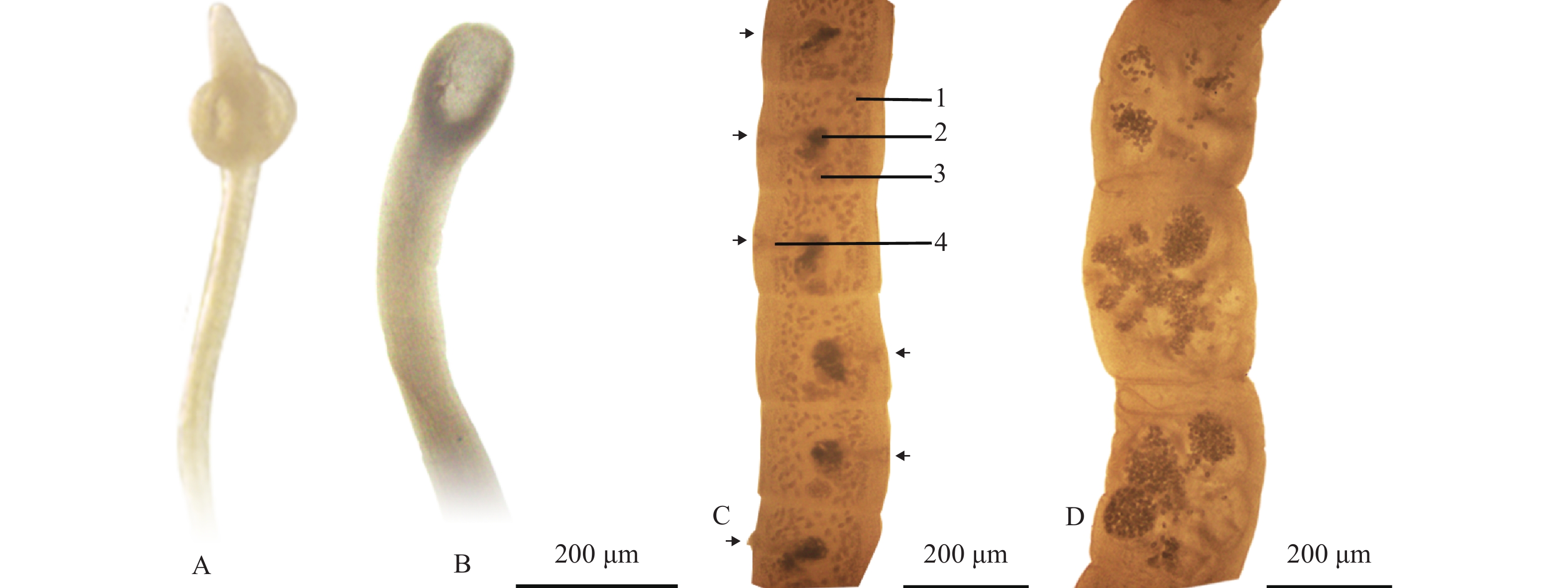
 下载:
下载:

